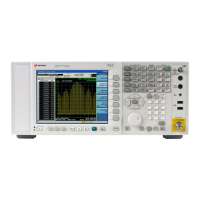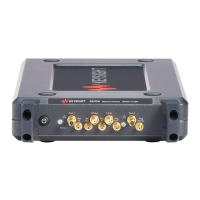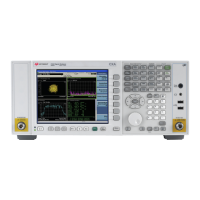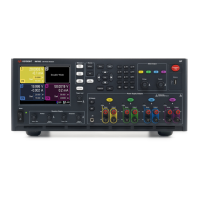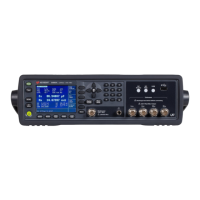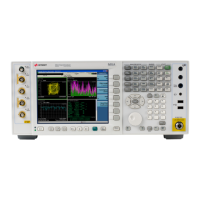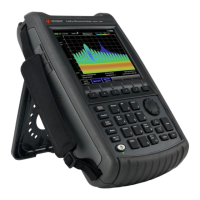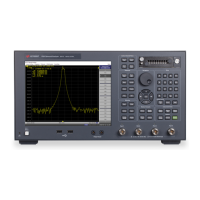Page 12
Find us at www.keysight.com
PNA-X Series Test Set and Power Configuration Options
1
(Continued)
4-ports, dual sources, with configurable test set
(Option 401)
The standard 4-port test set comes with 12 front-panel access
loops and a built-in second source. The loops provide access to
the signal path between (a) the source output and the reference
receiver, (b) the source output and directional coupler thru arm
and (c) the coupled arm of the directional coupler and the port
receiver. The internal second source provides an additional
signal (fixed or swept) for two-tone intermodulation testing of
amplifiers, or for use as a local oscillator when testing mixers and
frequency converters. Source 1 is accessible through test ports 1
and 2, and source 2 is accessible through test ports 3 and 4. The
standard test set also includes a solid-state internal RF bypass
switch in the R1 reference-receiver path.
Test port 3
C
R3
Test port 1
R1
Test port 4
R4
Test port 2
R2
A D B
Source 2
OUT 1 OUT 2
Pulse
modulator
Source 1
OUT 1 OUT 2
Pulse
modulator
Pulse generators
To receivers
LO
R A B C D
IF inputs
Rear panel
C
R3
R1
R4 R2
35 dB
65 dB
35 dB
65 dB 65 dB
35 dB
65 dB
A
35 dB
D B
OUT 1 OUT 2
Pulse
modulator
OUT 1 OUT 2
Pulse
modulator
To receivers
LO
R A B C D
IF inputs
Rear panel
Source 1
Source 2
Test port 1
Test port 3
Test port 2
Pulse generators
Test port 4
1. The block diagrams shown above include hardware that must be ordered
as separate options, such as pulse modulators (Options 021 and 022),
and IF access (Option 020), or is controlled by application software, as
is the case for the pulse generators. In addition, the combiner type and
attenuator values vary by model number. Refer to the product data sheet
for the correct block diagram for a specific model.
4-ports, dual sources, with extended power range
(Option 417)
This configuration comes with two sources, front-panel
access loops, and source and receiver attenuators at each
port. The source attenuators are settable in 5 dB steps up
to 65 dB in N5241/42/49B, and in 10 dB steps up to 60 dB
in N5244/45B. The receiver attenuators are settable in 5 dB
steps up to 35 dB. The maximum power rating on the test
port couplers is +43 dBm (additional attenuators or isolators
are typically required to protect other components inside the
instrument). Option 417 is not available on the N5247B. To
independently control the frequency of the second internal
source, one of the following software applications is required:
S93080/029/082/083/084/086/087/089/090x/093/094B/A,
and S94510/511A.
R1
Test port 2
R2
A
B
To receivers
LO
Source 2
Output 1
Source 2
Output 2
Pulse generators
Rear panel
1
2
3
4
Test port 1
Source 1
OUT 1 OUT 2
Pulse
modulator
Source 2
OUT 1 OUT 2
Pulse
modulator
J9J10J11 J8 J7 J2 J1
35 dB
65 dB
35 dB
65 dB
J6 J5
RF
OUT
LO
OUT
R R1 R2A B
IF inputs
2-ports, dual sources, with extended power
range, bias tees, and mechanical switches
(Option 224)
Along with the access loops, attenuators, and bias tees of
Option 219, Option 224 includes an internal second source, a
combiner, mechanical switches, and more access loops. The
internal second source provides an additional signal (fixed or
swept) for two-tone intermodulation testing of amplifiers, or
for use as a local oscillator for testing mixers and frequency
converters. The mechanical switches switch the combiner in
and out as needed, as well as enabling the additional access
loops for advanced configurations. The second source is
available through two RF connectors on the front panel,
from port 1 when combined with source 1, or via rear-panel
(N5241/42/44/45/49B) or front-panel (N5247B) access
loops. The bias tees are connected directly to the test port
couplers, which limits the maximum power rating on the pair
to +30 dBm (additional attenuators or isolators are typically
required to protect other components inside the instrument).
To independently control the frequency of the second internal
source, one of the following software applications is required:
S93080/029/082/083/084/086/087/089/090x/093/094B/A.
To independently control the frequency of the second internal
source, one of the following software applications is required:
S93080/029/082/083/084/086/087/089/090x/093/094B/A.
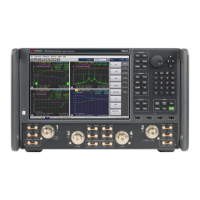
